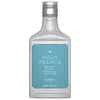What's inside
What's inside
 Key Ingredients
Key Ingredients

No key ingredients
 Benefits
Benefits

 Concerns
Concerns

 Ingredients Side-by-side
Ingredients Side-by-side

Water
Skin ConditioningGlycerin
HumectantSodium Lauroyl Methyl Isethionate
CleansingSodium Laurylglucosides Hydroxypropylsulfonate
CleansingCocamidopropyl Hydroxysultaine
CleansingAcrylates Copolymer
Pyrus Malus Fruit Extract
Skin ConditioningPhenoxyethanol
PreservativeSodium Chloride
MaskingGuar Hydroxypropyltrimonium Chloride
Skin ConditioningSodium Hydroxide
BufferingDipotassium Glycyrrhizate
HumectantPanthenol
Skin ConditioningEthylhexylglycerin
Skin ConditioningCitric Acid
BufferingWater, Glycerin, Sodium Lauroyl Methyl Isethionate, Sodium Laurylglucosides Hydroxypropylsulfonate, Cocamidopropyl Hydroxysultaine, Acrylates Copolymer, Pyrus Malus Fruit Extract, Phenoxyethanol, Sodium Chloride, Guar Hydroxypropyltrimonium Chloride, Sodium Hydroxide, Dipotassium Glycyrrhizate, Panthenol, Ethylhexylglycerin, Citric Acid
Water
Skin ConditioningSodium Cocoyl Isethionate
CleansingSodium Lauroyl Methyl Isethionate
CleansingGlycerin
HumectantSodium Lauroyl Lactylate
EmulsifyingDecyl Glucoside
CleansingAcrylates Crosspolymer-4
Emulsion StabilisingDisteareth-75 Ipdi
Artocarpus Heterophyllus Fruit Extract
Skin ConditioningHydrolyzed Vegetable Protein
Skin ConditioningHydrolyzed Pea Protein
EmollientOpuntia Ficus-Indica Seed Oil
EmollientLactobacillus Ferment
Skin ConditioningSodium PCA
HumectantMaltol
MaskingPolyquaternium-80
CleansingPhospholipids
Skin ConditioningPolyquaternium-16
Lactic Acid
BufferingUrea
BufferingGlycine
BufferingNiacinamide
SmoothingAllantoin
Skin ConditioningAlanine
MaskingSerine
MaskingSodium Hyaluronate
HumectantTocopheryl Acetate
AntioxidantPotassium Hydroxide
BufferingGlycol Distearate
EmollientAloe Barbadensis Leaf Juice
Skin ConditioningSqualane
EmollientAmaranthus Caudatus Seed Extract
Skin ConditioningMauritia Flexuosa Fruit Oil
Skin ConditioningHelianthus Annuus Seed Oil
EmollientPanthenol
Skin ConditioningGuar Hydroxypropyltrimonium Chloride
Skin ConditioningRosmarinus Officinalis Leaf Extract
AntimicrobialDiisostearyl Malate
EmollientTocopherol
AntioxidantCitric Acid
BufferingTrisodium Ethylenediamine Disuccinate
Sodium Phytate
Potassium Sorbate
PreservativeSodium Benzoate
MaskingPhenoxyethanol
PreservativeParfum
MaskingWater, Sodium Cocoyl Isethionate, Sodium Lauroyl Methyl Isethionate, Glycerin, Sodium Lauroyl Lactylate, Decyl Glucoside, Acrylates Crosspolymer-4, Disteareth-75 Ipdi, Artocarpus Heterophyllus Fruit Extract, Hydrolyzed Vegetable Protein, Hydrolyzed Pea Protein, Opuntia Ficus-Indica Seed Oil, Lactobacillus Ferment, Sodium PCA, Maltol, Polyquaternium-80, Phospholipids, Polyquaternium-16, Lactic Acid, Urea, Glycine, Niacinamide, Allantoin, Alanine, Serine, Sodium Hyaluronate, Tocopheryl Acetate, Potassium Hydroxide, Glycol Distearate, Aloe Barbadensis Leaf Juice, Squalane, Amaranthus Caudatus Seed Extract, Mauritia Flexuosa Fruit Oil, Helianthus Annuus Seed Oil, Panthenol, Guar Hydroxypropyltrimonium Chloride, Rosmarinus Officinalis Leaf Extract, Diisostearyl Malate, Tocopherol, Citric Acid, Trisodium Ethylenediamine Disuccinate, Sodium Phytate, Potassium Sorbate, Sodium Benzoate, Phenoxyethanol, Parfum
 Reviews
Reviews

Ingredients Explained
These ingredients are found in both products.
Ingredients higher up in an ingredient list are typically present in a larger amount.
Citric Acid is an alpha hydroxy acid (AHA) naturally found in citrus fruits like oranges, lemons, and limes.
Like other AHAs, citric acid can exfoliate skin by breaking down the bonds that hold dead skin cells together. This helps reveal smoother and brighter skin underneath.
However, this exfoliating effect only happens at high concentrations (20%) which can be hard to find in cosmetic products.
Due to this, citric acid is usually included in small amounts as a pH adjuster. This helps keep products slightly more acidic and compatible with skin's natural pH.
In skincare formulas, citric acid can:
While it can provide some skin benefits, research shows lactic acid and glycolic acid are generally more effective and less irritating exfoliants.
Most citric acid used in skincare today is made by fermenting sugars (usually from molasses). This synthetic version is identical to the natural citrus form but easier to stabilize and use in formulations.
Read more about some other popular AHA's here:
Learn more about Citric AcidGlycerin is already naturally found in your skin. It helps moisturize and protect your skin.
A study from 2016 found glycerin to be more effective as a humectant than AHAs and hyaluronic acid.
As a humectant, it helps the skin stay hydrated by pulling moisture to your skin. The low molecular weight of glycerin allows it to pull moisture into the deeper layers of your skin.
Hydrated skin improves your skin barrier; Your skin barrier helps protect against irritants and bacteria.
Glycerin has also been found to have antimicrobial and antiviral properties. Due to these properties, glycerin is often used in wound and burn treatments.
In cosmetics, glycerin is usually derived from plants such as soybean or palm. However, it can also be sourced from animals, such as tallow or animal fat.
This ingredient is organic, colorless, odorless, and non-toxic.
Glycerin is the name for this ingredient in American English. British English uses Glycerol/Glycerine.
Learn more about GlycerinThis ingredient is derived from guar gum.
It is a conditioning ingredient, meaning it helps soften skin and hair.
Panthenol is a common ingredient that helps hydrate and soothe the skin. It is found naturally in our skin and hair.
There are two forms of panthenol: D and L.
D-panthenol is also known as dexpanthenol. Most cosmetics use dexpanthenol or a mixture of D and L-panthenol.
Panthenol is famous due to its ability to go deeper into the skin's layers. Using this ingredient has numerous pros (and no cons):
Like hyaluronic acid, panthenol is a humectant. Humectants are able to bind and hold large amounts of water to keep skin hydrated.
This ingredient works well for wound healing. It works by increasing tissue in the wound and helps close open wounds.
Once oxidized, panthenol converts to pantothenic acid. Panthothenic acid is found in all living cells.
This ingredient is also referred to as pro-vitamin B5.
Learn more about PanthenolPhenoxyethanol is a preservative that has germicide, antimicrobial, and aromatic properties. Studies show that phenoxyethanol can prevent microbial growth. By itself, it has a scent that is similar to that of a rose.
It's often used in formulations along with Caprylyl Glycol to preserve the shelf life of products.
Sodium Lauroyl Methyl Isethionate is a cleansing ingredient. It is a surfactant, meaning it helps gather dirt, oil, and other pollutants. This helps them be rinsed away easily.
Water. It's the most common cosmetic ingredient of all. You'll usually see it at the top of ingredient lists, meaning that it makes up the largest part of the product.
So why is it so popular? Water most often acts as a solvent - this means that it helps dissolve other ingredients into the formulation.
You'll also recognize water as that liquid we all need to stay alive. If you see this, drink a glass of water. Stay hydrated!
Learn more about Water